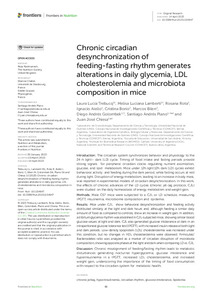Por favor, use este identificador para citar o enlazar este ítem:
https://repositorio.uca.edu.ar/handle/123456789/16477| Título: | Chronic circadian desynchronization of feeding-fasting rhythm generates alterations in daily glycemia, LDL cholesterolemia and microbiota composition in mice | Autor: | Trebucq, Laura Lucía Lamberti, Melisa Luciana Rota, Rosana Borio, Cristina Bilen, Marcos Golombek, Diego A. Plano, Santiago Andrés Chiesa, Juan José |
Palabras clave: | RITMO CIRCADIANO; INTOLERANCIA; GLUCOSA; LIPIDOS; NUTRIENTES; AUMENTO DE PESO; METABOLISMO | Fecha de publicación: | 2023 | Editorial: | Frontiers Media | Cita: | Trebucq, L. L. et al. Chronic circadian desynchronization of feeding-fasting rhythm generates alterations in daily glycemia, LDL cholesterolemia and microbiota composition in mice [en línea]. Frontiers in Nutrition. 2023, 10. doi:10.3389/fnut.2023.1154647. Disponible en: https://repositorio.uca.edu.ar/handle/123456789/16477 | Resumen: | Abstract: Introduction: The circadian system synchronizes behavior and physiology to the 24-h light– dark (LD) cycle. Timing of food intake and fasting periods provide strong signals for peripheral circadian clocks regulating nutrient assimilation, glucose, and lipid metabolism. Mice under 12h light:12h dark (LD) cycles exhibit behavioral activity and feeding during the dark period, while fasting occurs at rest during light. Disruption of energy metabolism, leading to an increase in body mass, was reported in experimental models of circadian desynchronization. In this work, the effects of chronic advances of the LD cycles (chronic jet-lag protocol, CJL) were studied on the daily homeostasis of energy metabolism and weight gain. Methods: Male C57 mice were subjected to a CJL or LD schedule, measuring IPGTT, insulinemia, microbiome composition and lipidemia. Results: Mice under CJL show behavioral desynchronization and feeding activity distributed similarly at the light and dark hours and, although feeding a similar daily amount of food as compared to controls, show an increase in weight gain. In addition, ad libitum glycemia rhythm was abolished in CJL-subjected mice, showing similar blood glucose values at light and dark. CJL also generated glucose intolerance at dark in an intraperitoneal glucose tolerance test (IPGTT), with increased insulin release at both light and dark periods. Low-density lipoprotein (LDL) cholesterolemia was increased under this condition, but no changes in HDL cholesterolemia were observed. Firmicutes/ Bacteroidetes ratio was analyzed as a marker of circadian disruption of microbiota composition, showing opposite phases at the light and dark when comparing LD vs. CJL. Discussion: Chronic misalignment of feeding/fasting rhythm leads to metabolic disturbances generating nocturnal hyperglycemia, glucose intolerance and hyperinsulinemia in a IPGTT, increased LDL cholesterolemia, and increased weight gain, underscoring the importance of the timing of food consumption with respect to the circadian system for metabolic health. | URI: | https://repositorio.uca.edu.ar/handle/123456789/16477 | ISSN: | 2296-861X (online) | Disciplina: | MEDICINA | DOI: | 10.3389/fnut.2023.1154647 | Derechos: | Acceso abierto | Fuente: | Frontiers in Nutrition. 2023, 10 |
| Aparece en las colecciones: | Artículos |
Ficheros en este ítem:
| Fichero | Descripción | Tamaño | Formato | |
|---|---|---|---|---|
| chronic-circadian-desynchronization.pdf | 1,14 MB | Adobe PDF |  Visualizar/Abrir |
Visualizaciones de página(s)
52
comprobado en 27-abr-2024
Descarga(s)
25
comprobado en 27-abr-2024
Google ScholarTM
Ver en Google Scholar
Altmetric
Altmetric
Este ítem está sujeto a una Licencia Creative Commons

